Abstract
A large number of cultures of gram-negative bacteria were examined for their susceptibility to various concentrations of cefamandole, cefoxitin, carbenicillin, and nalidixic acid. Heterogeneity of susceptibility was demonstrated in individual cultures to all of these antibiotics. Resistant clones isolated from cefamandole or cefoxitin plates were examined for β-lactamase production. Approximately 13% of 262 resistant clones acquired the ability to produce a β-lactamase. Examination of the substrate profile of the β-lactamases from some of these clones revealed no change in the specific activity of these enzymes for cefamandole, cephaloridine, or compound 87/312 as compared with their parental enzymes. This study clearly shows that some resistant clones do not produce β-lactamases, whereas some susceptible strains produced significant amounts of these enzymes. We conclude from these findings that little correlation exists between β-lactamase production and decreased susceptibility to cefamandole or cefoxitin. The results suggest the possibility that characteristics other than β-lactamase production may be responsible for resistance in Enterobacteriaceae.
Full text
PDF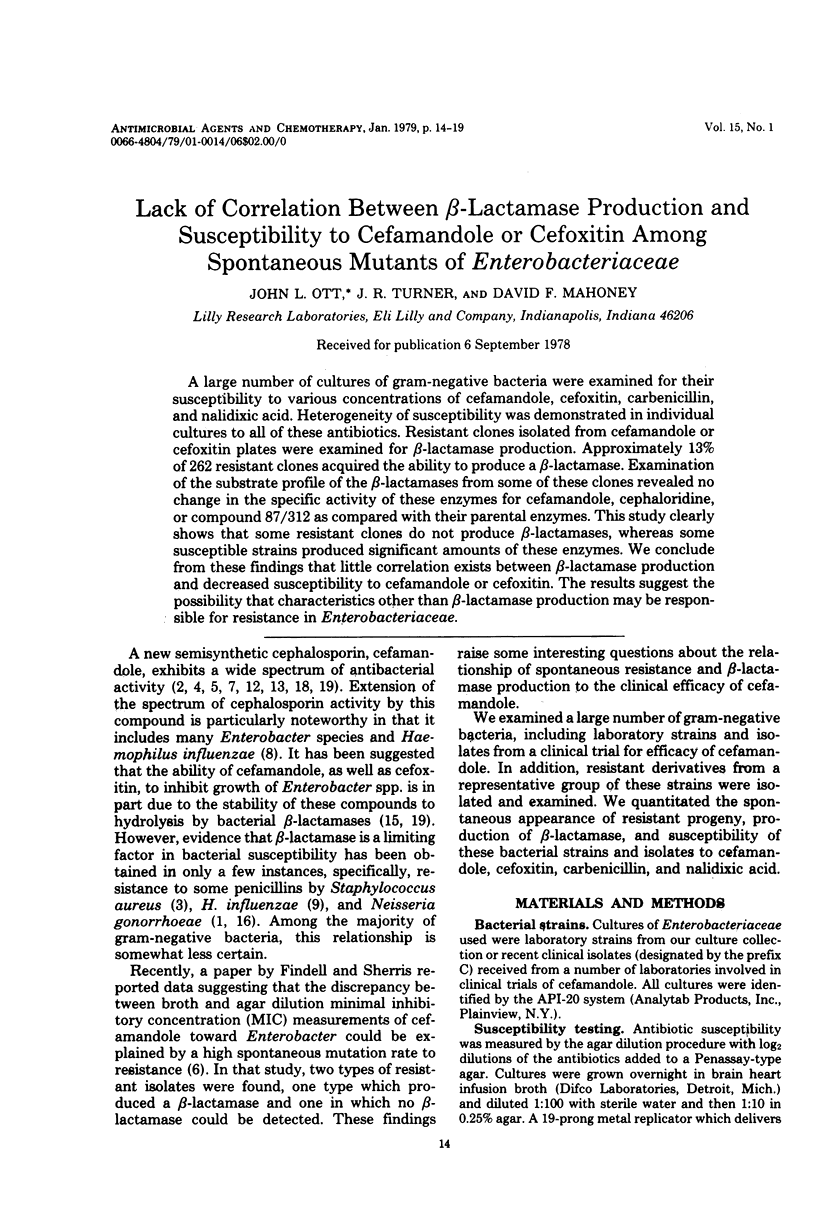
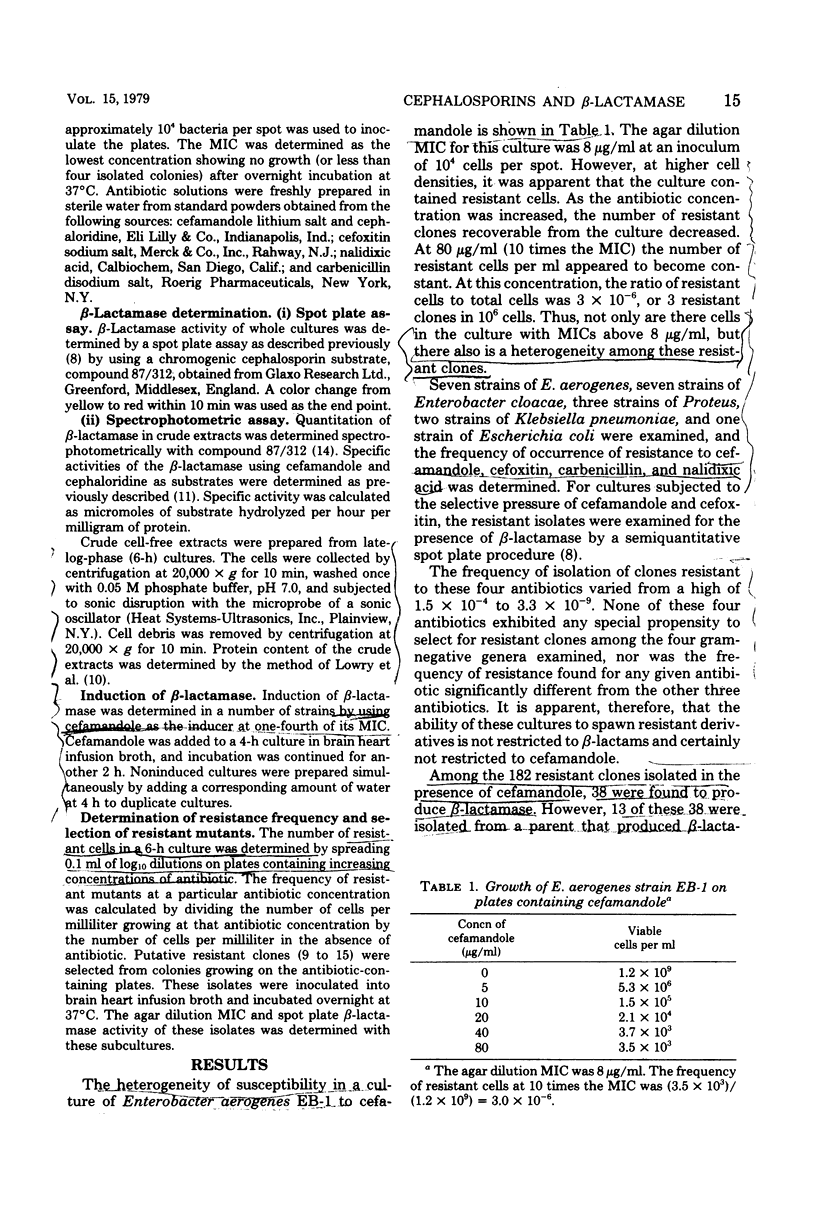
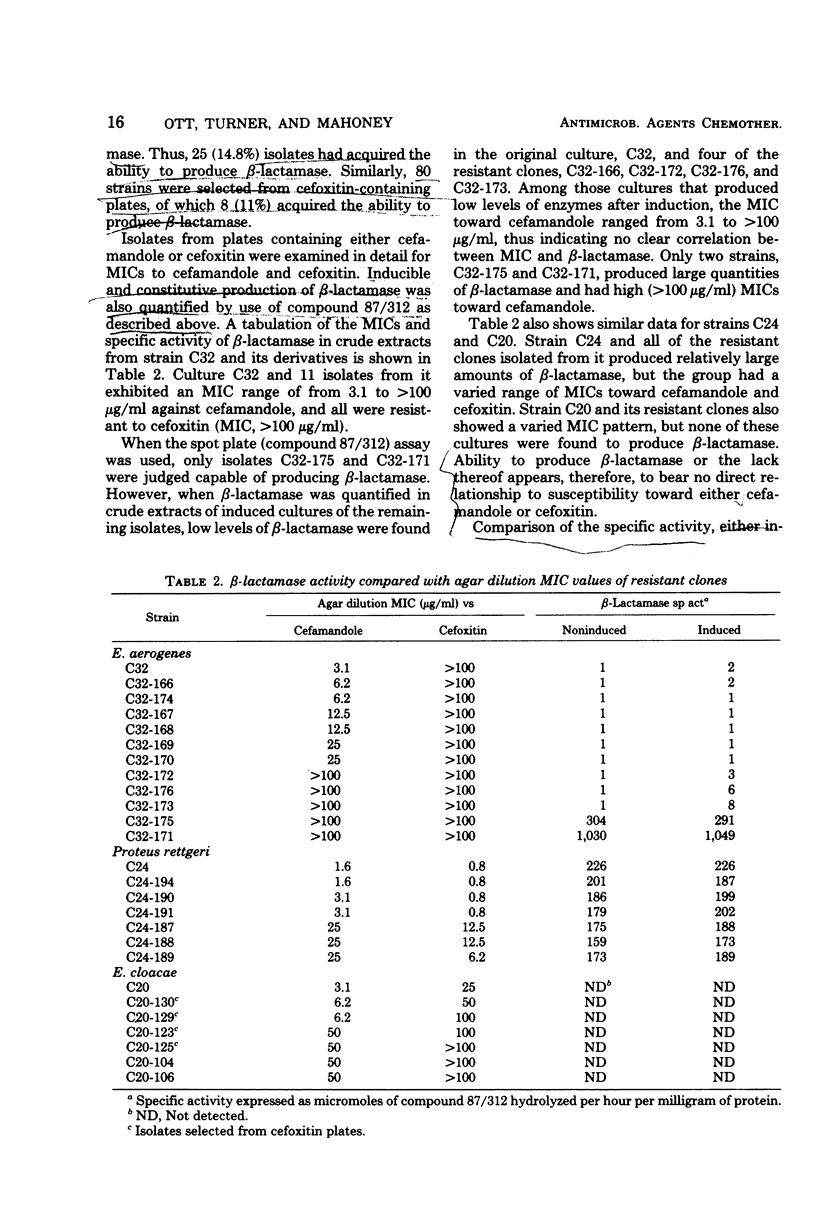
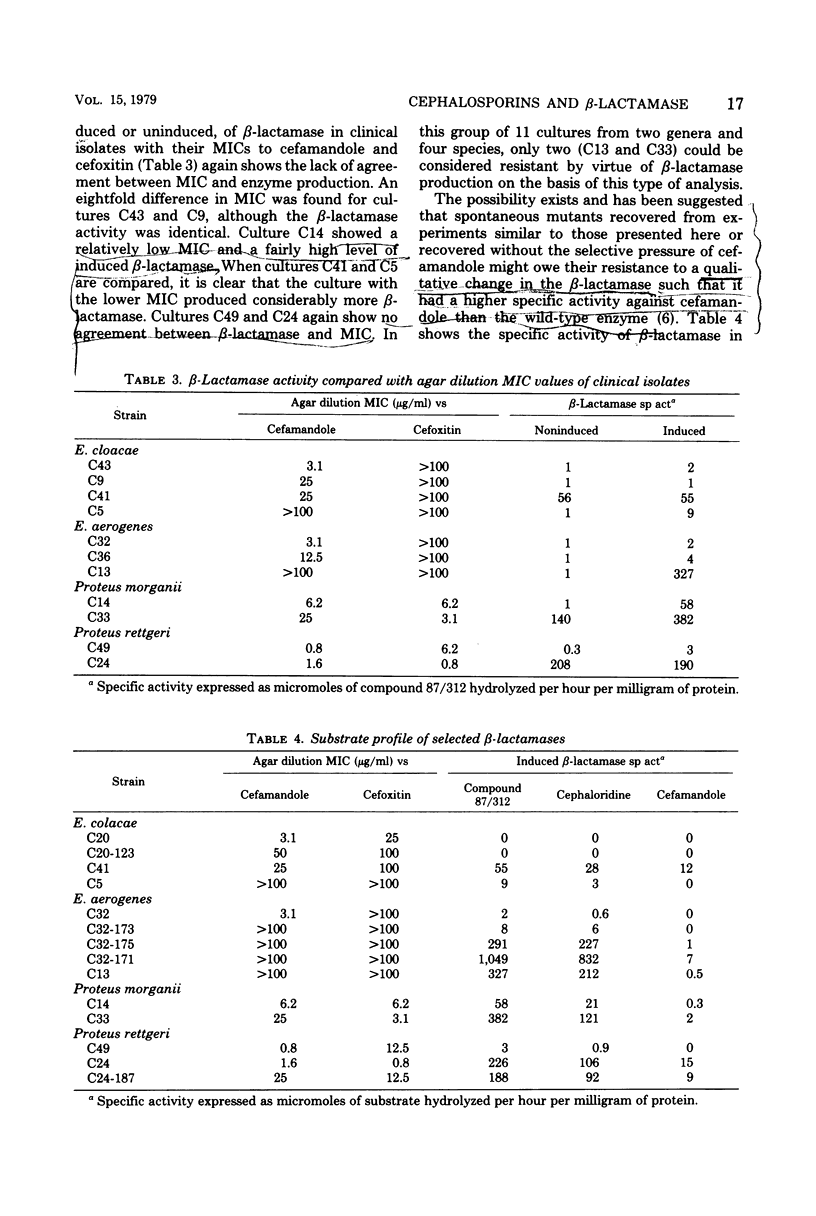
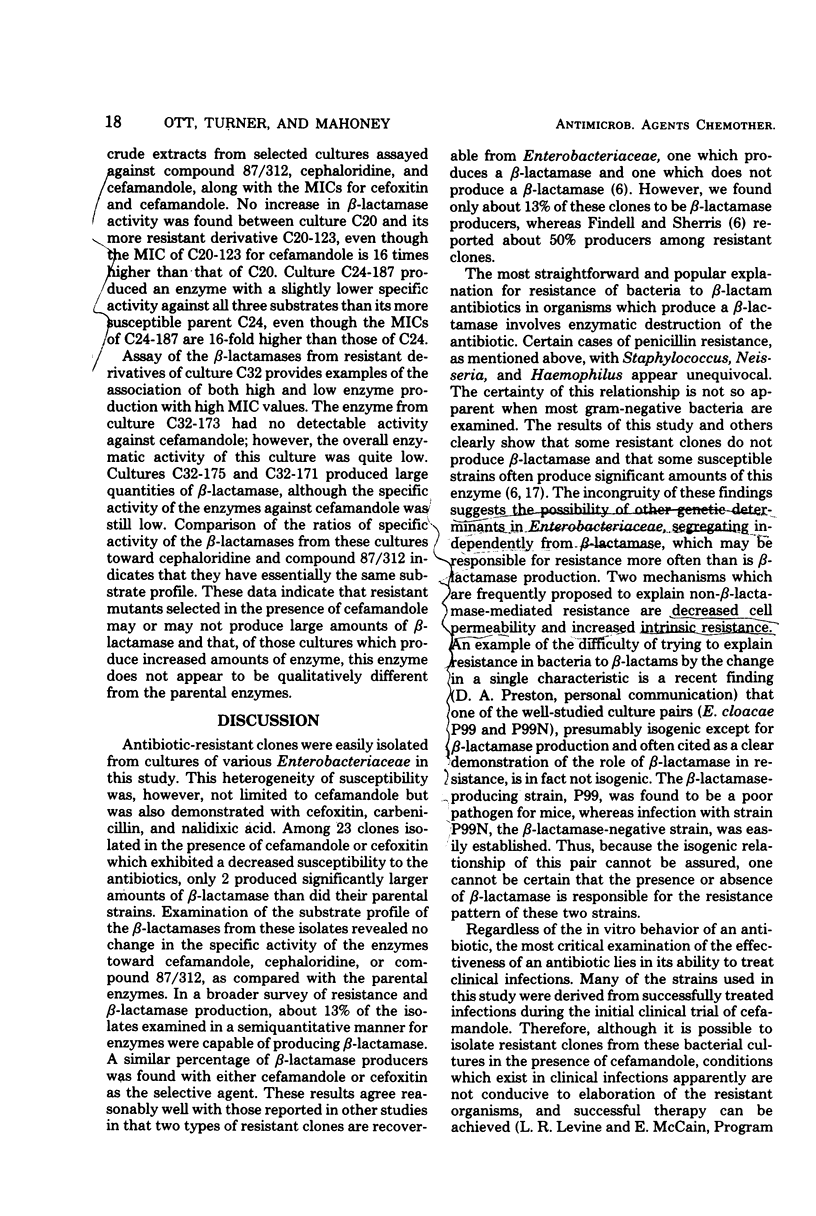
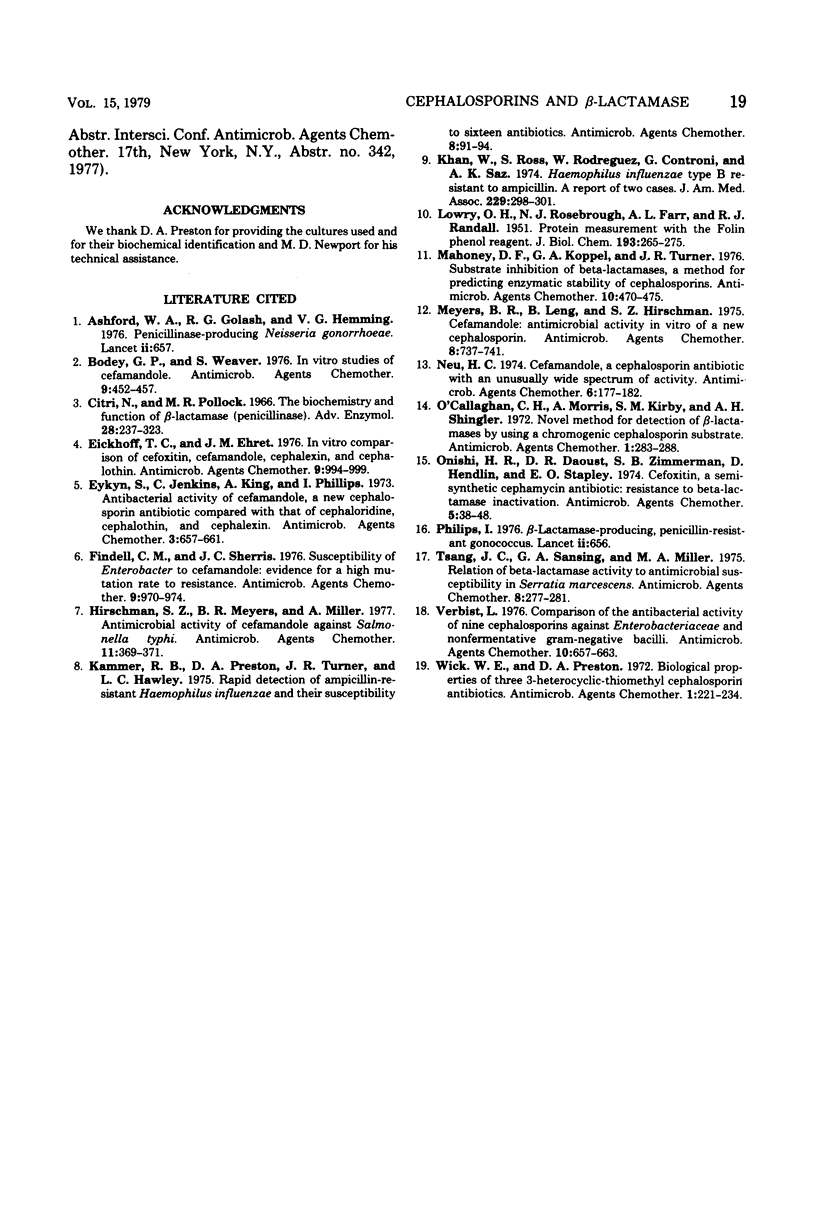
Selected References
These references are in PubMed. This may not be the complete list of references from this article.
- Ashford W. A., Golash R. G., Hemming V. G. Penicillinase-producing Neisseria gonorrhoeae. Lancet. 1976 Sep 25;2(7987):657–658. doi: 10.1016/s0140-6736(76)92467-3. [DOI] [PubMed] [Google Scholar]
- Bodey G. P., Weaver S. In vitro studies of cefamandole. Antimicrob Agents Chemother. 1976 Mar;9(3):452–457. doi: 10.1128/aac.9.3.452. [DOI] [PMC free article] [PubMed] [Google Scholar]
- Citri N., Pollock M. R. The biochemistry and function of beta-lactamase (penicillinase). Adv Enzymol Relat Areas Mol Biol. 1966;28:237–323. doi: 10.1002/9780470122730.ch4. [DOI] [PubMed] [Google Scholar]
- Eickhoff T. C., Ehret J. M. In vitro comparison of cefoxitin, cefamandole, cephalexin, and cephalothin. Antimicrob Agents Chemother. 1976 Jun;9(6):994–999. doi: 10.1128/aac.9.6.994. [DOI] [PMC free article] [PubMed] [Google Scholar]
- Eykyn S., Jenkins C., King A., Phillips I. Antibacterial activity of cefamandole, a new cephalosporin antibiotic, compared with that of cephaloridine, cephalothin, and cephalexin. Antimicrob Agents Chemother. 1973 Jun;3(6):657–661. doi: 10.1128/aac.3.6.657. [DOI] [PMC free article] [PubMed] [Google Scholar]
- Findell C. M., Sherris J. C. Susceptibility of Enterobacter to cefamandole: evidence for a high mutation rate to resistance. Antimicrob Agents Chemother. 1976 Jun;9(6):970–974. doi: 10.1128/aac.9.6.970. [DOI] [PMC free article] [PubMed] [Google Scholar]
- Hirschman S. Z., Meyers B. R., Miller A. Antimicrobial activity of cefamandole against Salmonella typhi. Antimicrob Agents Chemother. 1977 Feb;11(2):369–371. doi: 10.1128/aac.11.2.369. [DOI] [PMC free article] [PubMed] [Google Scholar]
- Kammer R. B., Preston D. A., Turner J. R., Hawley L. C. Rapid detection of ampicillin-resistant Haemophilus influenzae and their susceptibility to sixteen antibiotics. Antimicrob Agents Chemother. 1975 Jul;8(1):91–94. doi: 10.1128/aac.8.1.91. [DOI] [PMC free article] [PubMed] [Google Scholar]
- Khan W., Ross S., Rodriguez W., Controni G., Saz A. K. Haemophilus influenzae type B resistant to ampicillin. A report of two cases. JAMA. 1974 Jul 15;229(3):298–301. [PubMed] [Google Scholar]
- LOWRY O. H., ROSEBROUGH N. J., FARR A. L., RANDALL R. J. Protein measurement with the Folin phenol reagent. J Biol Chem. 1951 Nov;193(1):265–275. [PubMed] [Google Scholar]
- Mahoney D. F., Koppel G. A., Turner J. R. Substrate inhibition of beta-lactamases, a method for predicting enzymatic stability of cephalosporins. Antimicrob Agents Chemother. 1976 Sep;10(3):470–475. doi: 10.1128/aac.10.3.470. [DOI] [PMC free article] [PubMed] [Google Scholar]
- Meyers B. R., Leng B., Hirschman S. Z. Cefamandole: antimicrobial activity in vitro of a new cephalosporin. Antimicrob Agents Chemother. 1975 Dec;8(6):737–741. doi: 10.1128/aac.8.6.737. [DOI] [PMC free article] [PubMed] [Google Scholar]
- Neu H. C. Cefamandole, a cephalosporin antibiotic with an unusually wide spectrum of activity. Antimicrob Agents Chemother. 1974 Aug;6(2):177–182. doi: 10.1128/aac.6.2.177. [DOI] [PMC free article] [PubMed] [Google Scholar]
- O'Callaghan C. H., Morris A., Kirby S. M., Shingler A. H. Novel method for detection of beta-lactamases by using a chromogenic cephalosporin substrate. Antimicrob Agents Chemother. 1972 Apr;1(4):283–288. doi: 10.1128/aac.1.4.283. [DOI] [PMC free article] [PubMed] [Google Scholar]
- Onishi H. R., Daoust D. R., Zimmerman S. B., Hendlin D., Stapley E. O. Cefoxitin, a semisynthetic cephamycin antibiotic: resistance to beta-lactamase inactivation. Antimicrob Agents Chemother. 1974 Jan;5(1):38–48. doi: 10.1128/aac.5.1.38. [DOI] [PMC free article] [PubMed] [Google Scholar]
- Tsang J. C., Sansing G. A., Miller M. A. Relation of beta-lactamase activity to antimicrobial susceptibility in Serratia marcescens. Antimicrob Agents Chemother. 1975 Sep;8(3):277–281. doi: 10.1128/aac.8.3.277. [DOI] [PMC free article] [PubMed] [Google Scholar]
- Verbist L. Comparison of the antibacterial activity of nine cephalosporins against Enterobacteriaceae and nonfermentative gram-negative bacilli. Antimicrob Agents Chemother. 1976 Oct;10(4):657–663. doi: 10.1128/aac.10.4.657. [DOI] [PMC free article] [PubMed] [Google Scholar]
- Wick W. E., Preston D. A. Biological properties of three 3-heterocyclic-thiomethyl cephalosporin antibiotics. Antimicrob Agents Chemother. 1972 Mar;1(3):221–234. doi: 10.1128/aac.1.3.221. [DOI] [PMC free article] [PubMed] [Google Scholar]


